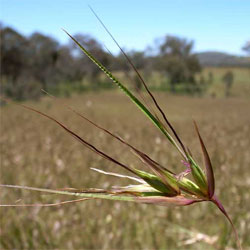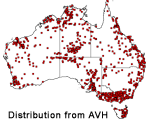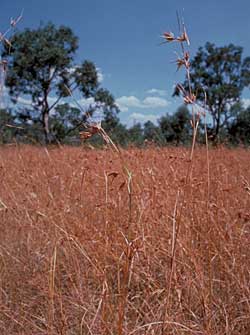Themeda triandra
 |
Previously called Themeda australis
Kangaroo Grass
The widespread Kangaroo Grass, Themeda triandra, is one of the most recognisable members of the grass family (Poaceae) in Australia. Themeda triandra is considered by some to be two species, the African and Asian species T. triandra and a separate Australian species Themeda australis. As there does not seem to be enough distinguishable differences between them to warrant the split they are generally considered one species, although many publications still use the name T. australis.
 The
species has a particularly wide distribution; in Australia it is found in all
states and territories, overseas it is found in Africa, Asia and the Pacific.
It commonly grows in grassland and open woodland communities.
The
species has a particularly wide distribution; in Australia it is found in all
states and territories, overseas it is found in Africa, Asia and the Pacific.
It commonly grows in grassland and open woodland communities.
Themeda triandra is a tufted perennial that can grow to 1.5 m tall and 0.5 m across. Its leaves are 10-50 cm long and 2-5 mm wide, green to grey drying to an orange brown in summer. The flowering period is from December to February. It produces distinct large red-brown spikelets, which occur on branched stems. Spikelets have long distinguishing spathes at their base and bare florets with black awns 4-7 cm long, which remain with the seed when it falls.
This attractive grass can be used as an ornamental in rockeries, as part of a native habitat garden or can be grown in a more formal garden for its interesting colour and texture. It grows in full sun to part shade on sandy to clay soils and needs little water once established. Because of its large distribution, growing conditions for T. triandra can be quite variable so it is best to source seeds or nursery stock native to your local area.
Kangaroo Grass can be grown from seed or by division of older clumps. Seed may be sown straight away with some success in mid summer to autumn but generally the seed has a dormancy period of up to 12 months depending on the area where it was collected. Fire or temperatures of 40–45° C may also break dormancy. Approximately 2/3 of seed collected from one inflorescence will be infertile. It is sometimes hard to distinguish fertile from infertile seeds as they both turn brown and retain their awns, but generally fertile seed is larger. If you are harvesting and sowing a lot of seed beware of the sharp callus (barb) at the base of the seed.
Seed can be planted 15 mm deep or spread like mulch when the whole inflorescences are harvested. Kangaroo Grass does not transplant well but success has been achieved with square tube stock pots which air prune the roots and stop the seedlings becoming root bound. When planted out, water crystals and slow release fertiliser should be placed in the hole with the seedling, it should then be watered in well.
The grass clumps do not need a lot of maintenance; dead leaves can be raked out and old seed heads removed from the base. If a neater appearance is required, the clumps can be cut back in early spring to encourage new green growth. This plant does not suffer any significant pest or disease problems.
Although Themeda triandra itself is not endangered as a species it does grow in Temperate Grassland communities, which have been declared as endangered in the Australian Capital Territory and threatened in Victoria. The grasslands are under threat due to loss and fragmentation through inadequate land management practices. As Kangaroo Grass does not tolerate heavy or continuous grazing, it can be a useful indicator of the level of disturbance in an area.
Text by Jennifer Liles (2004 Student Botanical Intern)
Derivation of the name: Themeda triandraThemeda - from the Arabic word thaemed, which means a depression in which water lies after rain, subsequently drying in summer. triandra - from the Greek words treis (three) and aner (man). |
References
ANBG (Australian National Botanic Gardens) (2004) Australian Plant Name Index. Available at: http://www.anbg.gov.au/cpbr/databases/apni.html [Accessed: 2004, 5 February].
Bains, J.A. (1981) Australian Plant Genera. The Society for Growing Australian Plants, NSW.
Burbridge, N.T. (1966) Australian Grasses, vol. 1, Angus and Robertson, Sydney.
Centre for Plant Biodiversity Research (2003) Australia’s Virtual Herbarium. Available at: http://www.cpbr.gov.au/avh/ [Accessed: 2004, 5 February].
Eddy, D., Mallinson, D., Rehwinkel, R. and Sharp, S. (2001) Grassland Flora. Environment ACT, Canberra.
ACT Government (1997) Natural Temperate Grassland: An endangered ecological community, Action Plan 1. Environment ACT, Canberra.
Lamp, C.A., Forbes, S.J. & Cade, J.W. (ed. Pressley, M.) (1990) Grasses of Temperate Australia. Inkata Press, Melbourne.
Mallett, K. & Orchard, A.E. (2002) The Flora of Australia, Poaceae 1. Vol. 43, ABRS/CSIRO Australia.
Simon, B.K. (1985) ‘What is the Correct Name for Kangaroo Grass?’ The Australian Systematic Botany Society Newsletter. Vol. 43.
Sharp, D. & Simon, B.K. (2002) AusGrass: Grasses of Australia. CD-ROM, version 1.0. CSIRO Publishing, Victoria.
Waters et al. (2000) Grassed Up. Information Delivery Program, NSW.
Wheeler, D.J.B. (1994) Grasses of New South Wales. University of New England, Armidale.
Wrigley, J.W. & Fagg, M. (2003) Australian Native Plants, 5th Edition. Reed New Holland, Australia.
![An Australian Government Initiative [logo]](/images/austgovt_brown_90px.gif)


